As the winter approaches panjeeri, natural unrefined sugar brittle and pinnis (energy balls) are a must to be made in every Punjabi household. I have been eating them since childhood and they are perfect for breakfast or an afternoon snack with a cup of tea and other warm drinks. After marriage, whenever I visited my parents’ home, my mother would always send me off with a box full of these goodies. When she passed away my connection with homemade panjeeri and pinnis also ended. Then after a few years, in my quest to document new and old recipes on my blog I started making it by learning tips and tricks from my older sister. Writing this has hit me with a big dose of nostalgia.
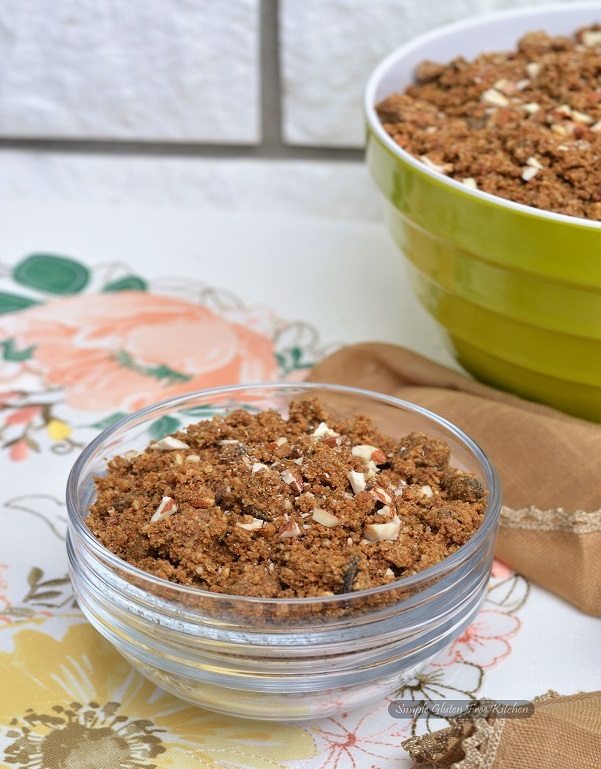
Panjeeri / Panjiri is a loose nutty mixture that has all kinds of healthy ingredients, popular in both Punjab (northern part of India) and Pakistan. It is treated as a high energy and high fiber food, made all through the year using ingredients suited for different seasons. The ingredients also vary depending on who is consuming and for what purpose. One variation of panjeeri is specifically made for new mothers because it’s known to aid in restoring lost strength and fortify breast milk. The one I am sharing today is good for everyone to enjoy in cold months. The ingredients used in it induces heat in the body, boosts immunity, builds strength and aids in aches and pains that are typically caused during winters. I also have another panjeeri/panjiri recipe on my blog that I make in summers which is light on the stomach and has anti-inflammatory properties.
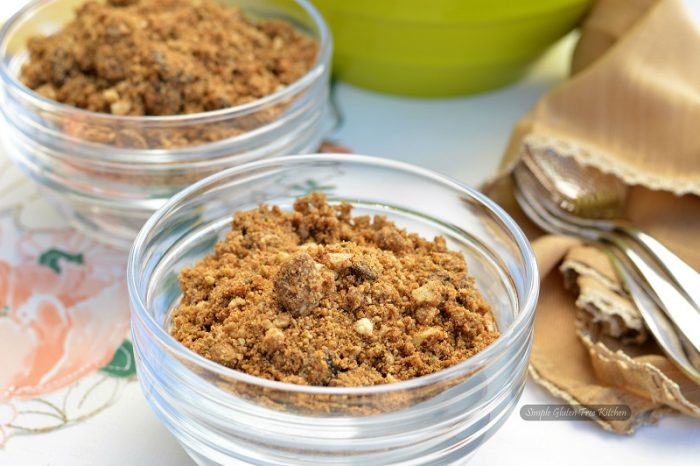
This image was taken without adding kamarkus
The primary ingredient in a panjeeri is whole wheat flour or besan (Bengal gram flour) which is roasted in ghee (clarified butter). In my recipe wheat flour is replaced with moong daal flour. I dry roasted the moong daal (the moss colored lentil) and ground it in a dry grain blender of Vitamix. Moong dal is a nutrient-rich food. It is packed with minerals like potassium, magnesium, iron, and copper. In addition to this, it also contains folate, fiber, and vitamin B6, apart from loads of high-quality protein. Compared to other lentils, moong dal is low on carbs, making it a very healthy option to include in your daily diet. Other ingredients that a panjeeri needs are dry fruits, nuts, seeds, herbs and herbal gums. They are roasted slowly, then chopped or coarsely ground and sweetened with sugar or jaggery powder.
You should eat this panjeeri with a healthy diet approach and be mindful of portions as it is addictive and delicious. 1/3 – 1/2 cup is good enough if eaten with milk on those mornings when you have no time to cook something fresh and warm.
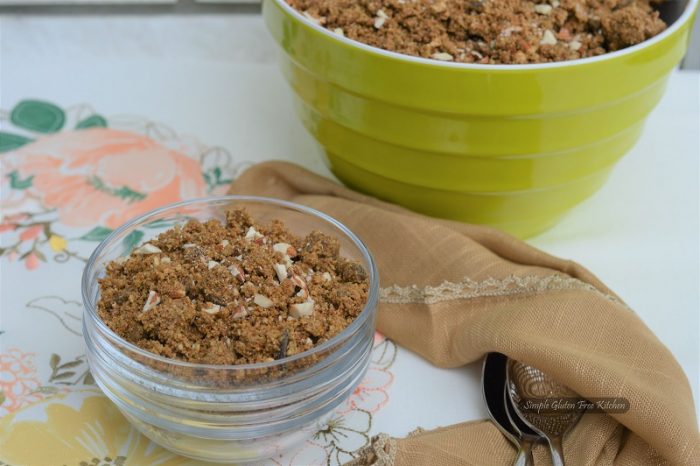
Variety of ingredients found in Panjeeri apart from the flour and ghee
Nuts (almonds, pistachios, cashews, walnuts)- High in protein, iron and Vitamin E, helps in healthy immune system.
Dates, raisins, apricots – Fiber, minerals, natural sugar, antimicrobial, boost iron levels, bone health
Coconut – high dietary fiber, vitamins and minerals
Seeds (Flax seeds, pumpkin seeds, sunflower seeds, sesame seeds) – low GI, fiber, protein, vitamins, minerals, antioxidants, and healthy fats.
Fox nuts or Lotus seeds – low in calories, protein, carbohydrates, vitamins and minerals, astringent and aphrodisiac properties.
Melon seeds – low calorie, good fats, vitamin C, rich in potassium, lignan, and zinc, stress buster
Herbs and Spices
- Fennel seeds- Anti-spasmodic, warming, antiseptic, contain phytonutrients, digestive friendly
- Ajwain (bishop’s seed) –Anti-spasmodic, warming, antiseptic, digestive friendly, promotes bile flow
- Soondh (Dry ginger powder) – Promotes circulation, warming, clears liver, antiseptic, digestive friendly
- Kamarkas (Butea monosperma, butea Frondosa)- The word kamarkus literally means “fortification of back muscles.” Since women usually feel back tiredness during menstrual cycle, over exertion, and post childbirth, kamarkas acts as a tonic to pelvic and back muscles
- Gond (Edible Gum) – Helps uterus contract, assist in healing, warming, source of fiber, pre-biotic
- Methi powder (Fenugreek) – bitter, improve lactation, balance cholesterol,
- Cumin seeds – antioxidant, bone health, potassium, regulate muscle contraction
Jaggery powder or Date sugar – unrefined sugar, warming, helps clear mucous, minerals
If you are not a new mom and/or plan on giving this to children leave out the Edible gum, cumin and fenugreek powder.
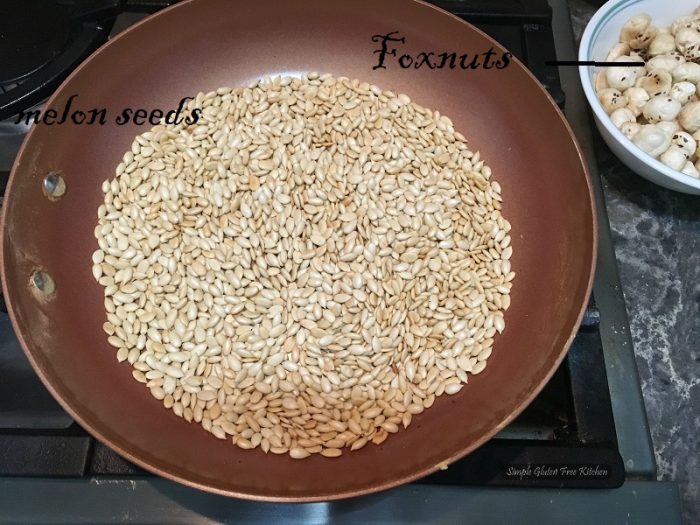
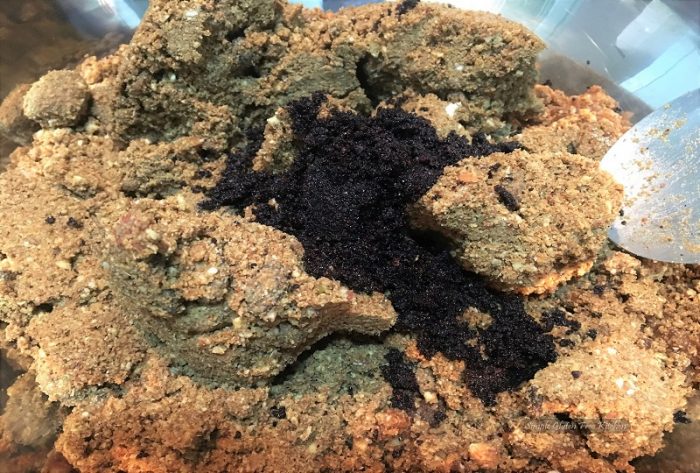
Quick notes and modifications to make Panjeeri
- The recipe is simple, but takes some time to prepare. If it hard to find whole mung use equal amount of either sorghum, oat, buckwheat, rice, millet, or mix and match of all.
- The trick to making a good panjeeri is to roast each ingredient (except raisins) slowly and separately because different ingredients toast at different rates. You just need to remove the rawness and make them fragrant and more flavorful. Make sure the heat is medium or low (depending on the intensity of your stove). Watch them closely while shaking the pan often or stirring frequently. The ingredients should change the color to golden or a shade or two darker and lighter in case of pumpkin seeds and edible gums. They give off a rich, toasty fragrance.
- If you have nut allergy skip almonds and increase the amount of seeds and lotus seeds.
- Ghee or coconut oil is vital component of this recipe. It coats and clumps the ingredients together and make it easy to eat and digest. Too little ghee makes panjeeri a bit dry and hard to swallow. I dry roast most of the ingredients and add ghee at the end as per requirement. Of course you can use olive oil instead of desi ghee but you are going to miss out on its rich and original taste.
- There is no one perfect Panjeeri recipe because every family makes it in their own way and puts their own little tweak to suit their taste and need. And, don’t worry about the exact amounts. Making panjeeri is more about the technique rather than the exact measurements. Feel free to add the ingredients you like or omit that you cannot find!
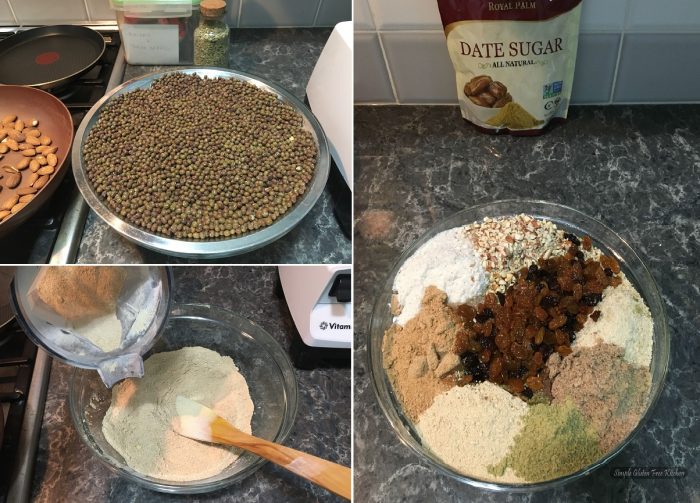
If you try this recipe do let me know how it went. Tag me on my Instagram, Facebook, twitter or leave a comment on the blog.
a delicious nutritional mix for winters
Ingredients
- 400 moong/ mung daal (washed and dried on towel, takes about 2 hours)
- 150 g almonds
- 150 gm raw unsalted seeds (melon, pumpkin and sunflower)
- 300 gm (+) date sugar
- 150 gm raisins
- 50 gm fennel seeds
- 100 gm fox nuts
- 160 gm Flax seeds
- 25-50 gm dry ginger powder
- 25-50 gm ajwain (Bishop seeds, grind without roasting)
- 1 3/4 cup (+) Desi ghee or coconut oil (I used refined coconut oil from nutiva)
Instructions
- In a heavy bottomed or non-stick pan, dry roast the whole moong/ mung on medium low heat, till it gets a nutty aroma i.e. approx. 8-10 minutes. Ensure stirring it with a spatula. You'll see that moss colored beans turns to beautiful copper brown color. Cool for 5 minutes and grind (1 cup at a time) in Vitamix using the dry grain container. Remove in a large bowl. If you do not have a Vitamix, use food processor or any high powered blender or coffee grinder. Working in batches, process until the lentils resemble a fine powder. There might be some bigger pieces left behind, so make sure to sift through a sieve and grind again.
- In the same pan, add almonds, roast them, stirring frequently, until they are golden brown and super aromatic. Remove on a cutting board, coarsely chop and add it to the ground daal.
- Next, add pumpkin seeds to the pan. Toast until they turn light brown, begin to pop, and smell fragrant. Stir frequently as the seeds toast. Transfer to a plate to cool, coarsely grind in coffee grinder.
- Dry roast sunflower seeds, melon seeds, fennel seeds, flax seeds, kamarkus, and fox nuts in the same way as pumpkin seeds and process in the food processor or coffee grinder. You want all of these to be grainy but not fine like a powder .
- Wipe the pan, add ghee or coconut oil on medium heat. Add raisins and roast until they puff up and begin to change color. Add it to the bowl with prepared panjeeri ingredients.
- Mix everything well to combine. Add date sugar and ginger powder, mix it again. Taste and adjust sweetness, as desired. If you feel that the mixture is dry or hard to down, feel free to add more ghee or coconut oil.
- Cool the Panjeeri completely. Store in a dry air-tight glass jar at room temperature. Consume as and when required.
Notes
Edible gum (Gond) is roasted in ghee till it puffs, then ground to add in the panjeeri but I have prepared this panjeeri without adding it.

Jess
I might not find some of the ingredients here in Germany but I am absolutely thrilled to see this recipe.
Balvinder
Thank you Jess!
Though you can find all the ingredients in an Indian store (if there is any in Germany) or online but yes you can omit which ever ingredient you do not like or find. Let me know how it goes.
Vasudha
Hello Balvinder
Sounds so delicious!
Have you used the whole green moong beans?
Can we use the split yellow moong beans( moong dhuli daal)
Balvinder
Long time no see, Vasudha! Thanks for visiting.
Yes, I used whole green mung but you can use split mung too.
angiesrecipes
This is a new combination of flavours for me…it surely looks very tasty!
Vasudha
Thanks for your quick reply.
I check all the recipes you post.
It sure has been a while since i contacted you.
I hope you are doing well.
Balvinder
Aww, thanks. Yes, I am well.
torviewtoronto
looks delicious
evi erlinda
It is really very healthy breakfast!
I love mung bean and those kinds of nuts.
Thanks for recipe, Balvider.
Swati
Delicious recipe for moong dal Panjiri..loved the use of whole moong beans.. very nutritious snack for winter..
Laura
Balvinder, this sounds delicious and healthy. These are many ingredients I am unfamiliar with, but I appreciate how healthy and lovely they are, as well as your memories of the dish from childhood.
John / Kitchen Riffs
This looks delish — fun recipe. And so many neat ingredients in it. Thanks!
Jeff the Chef
Sounds very interesting. I’ve never had anything like it!
Naila
Hi. Thanks for the recipe! How can it be made to fit a sugar free diet?
Balvinder
Its up to you how much sugar or sugar free option you want to use.